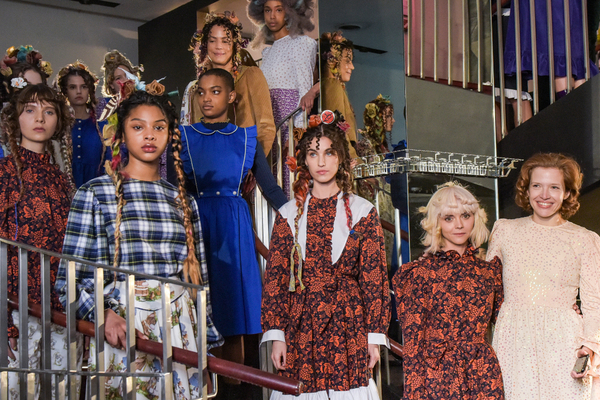The concept of a house dress is nothing new. Its history, dating back decades, has been well-documented. Essays have been written about it; blog posts have extolled its virtues. It hasn’t made a comeback, because it really hasn’t gone anywhere. What has happened is that, as most of the world continues to live in some version of lockdown, the humble garment has been a more frequent subject of conversation (and of quarantine purchases). And so, it finds itself in a spotlight of sorts.
Last month, Batsheva released a dedicated line of house dresses — a single short-sleeved, button-front silhouette available in four colorways, retailing for $210 a pop. Designer Batsheva Hay had actually begun exploring the idea of indoor/outdoor clothing (inspired by her neighbors on Manhattan’s Upper West Side) in her Spring 2020 collection, closing the show with her take on the style: a baggy, long-sleeved floral dress that hit just above the ankle. Even though she “loved it,” she says over the phone, “I got zero orders from retailers, so I kind of shelved it.”
Hay wasn’t discouraged, though: She included a velvet riff on a house dress in Fall 2020 that is making it into production, and she found herself coming back to and wearing the original samples. While many have found themselves gravitating towards sweats while in quarantine, they’re just not her thing. “I’m a dress person. I want to throw one thing on. And the dresses I’ve been making for years suited my life then, but they’re not what I want to wear at home,” she explains. That, plus conversations with her 91-year-old grandmother-in-law, reminiscing about the house dresses she and her mother used to wear, made Hay decide to release a new one.
“I still believe in this, but I think it was the quarantine that really made me think, ‘Fuck it, this is the moment,'” she adds. Batsheva is but one of the latest brands to enter this market of easy, comfortable dresses designed with practicality, prioritizing features like breathable fabrics and pockets. You can find one in pretty much every color, every silhouette, every price point. And they can be a big money-driver.
Hill House Home can attest to the power of the house dress: Founder Nell Diamond says that its “Nap Dresses” (yes, the name is trademarked), which the four-year-old company introduced in 2018, make up “over 50% of our business.” “Our biggest sales day ever was in December 2019, on the launch of the holiday plaid nap dresses. We launched our summer nap dresses [on July 1] and that replaced December as our biggest sales day ever by six times,” Diamond explains, noting that it’s also a frequent first purchase for the Hill House Home customer.
Though Hill House Home is primarily, as the name suggests, a home company, apparel was on the mind from the beginning: “I really had them in my mind when we launched the company but I wanted to take time developing them,” Diamond says. “It was really this idea that I wanted something that I could wear at home that was super comfortable but that was also really beautiful.” And customers’ fervor for the dresses has been there consistently. When it dropped its first collection of Nap Dresses two years ago, Hill House Home sold through six months of supply in a day — a trend it sees continue “even when we’re increasing our orders by 10x,” per Diamond. “We can’t keep up with the pace at all.”
Like with Batsheva’s line of house dresses, Hill House Home’s Nap Dresses were born out of the founder’s own love of them. “I feel like I’ve been somebody who’s been waiting their whole life to be cool and suddenly, everybody agrees with me. This is who I am. I am a house dress person,” Diamond says, adding that she’s always had one or two she’d wear exclusively at home. “As someone who has always gotten so much joy from fashion and clothing and dresses, I’ve always wanted [house dresses] to be comfortable,” she explains. “There’s this line from ‘Clueless’ that I always think about, where Cher is talking about how she doesn’t feel well and wonders, ‘Maybe it’s because my party clothes are so binding.’ Definitely I’m excited that people are in on this thing that we can have great, pretty things that are also comfortable and practical.”
While researching for her line of house dresses (which included ordering books on the garment and reading dissertations on the Internet), Hay came to discover how every decade has a house dress, based on the trends of the time. According to the designer, 2020’s version has to “be different. You can buy the other stuff at vintage stores. It has to be something that looks more modern, whether it’s the choice of fabric — which is one thing that I’m playing with — or the buttons, collars… Comfort is still part of it. But you want it to feel somehow considered and different.”
Hay acknowledges that house dresses might not be for everyone: “I definitely get comments that are like, ‘This is so frumpy and horrible.’ But that doesn’t dissuade me because when I started making prairie dresses, that was also the response,” Hay says. “There are always going to be people that don’t like it, that just respond to the frumpiness of it. Then there are some who are like, ‘Yes, this is what I’ve been waiting for.’ That’s what I always want to get: I don’t want to do what other people are doing — I want to push the envelope.”
“It’s really weird that something so old and basic and functional and frumpy is pushing the envelope,” she adds. “But that’s the world we live in.”
—
Photo Credit: FashionStock.com / Shutterstock.com
